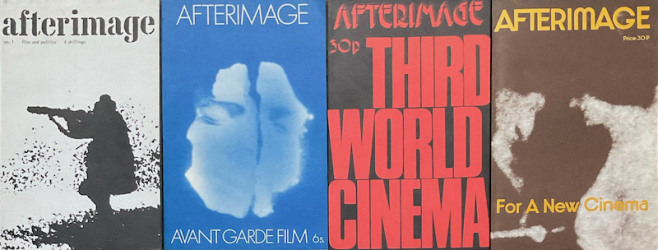Introduction Excerpt
The Afterimage Reader
Edited by Mark Webber
The Visible Press, May 2022
An excerpt from Mark Webber’s introduction to the book :-
The British film journal Afterimage published thirteen issues (one of them a double number) between 1970 and 1987. Each edition had a dedicated title, and was centred on a collective theme or on individual filmmakers. Despite the best of intentions towards maintaining a regular publishing schedule, Afterimage always appeared at irregular intervals; on one occasion three years passed between consecutive issues.
The magazine’s liberal remit was a focus on radical cinema in its many forms – the avant-garde, political filmmaking, early film, animation, and independent narrative features – and it was guided by a small group of editors of whom Simon Field was the only one to remain in post from first to last. His co-founder Peter Sainsbury worked through to No. 5, Ian Christie (using the nom de plume Guy L’éclair) helped to steer the magazine from No. 7 onwards, and Michael O’Pray joined, initially as a guest editor, for the final three issues.
Distinguished from many of its counterparts by its small format (roughly A5 sized, measuring approximately 14 ´ 21 cm), Afterimage was packed with serious and well-considered writing. Its scope was international, with subjects ranging from the Zanzibar Group and Cinema Novo to Paul Sharits or Soviet animators. Its pages, which interspersed densely set text with full-bleed images, were printed on a variety of stocks from easily legible white or cream offset paper to thick, dark brown and purple card that has been notoriously difficult to photocopy. Its cover designs were often abstract, foregoing the conventional use of recognisable film stills or personalities. The intention to produce a desirable and tactile physical object is clear to see.
Before Afterimage, there was Platinum – a single-issue magazine produced by Simon Field and Peter Sainsbury while they were still students at Essex University in the late 1960s. […] Platinum and Afterimage, were among a wave of new publications emerging from British universities and film aficionados. These included Motion (Ian Johnson, 1961-63), Movie (Ian Cameron, 1962-2010), Cinim (London Film-Makers’ Co-operative, 1966-69), Brighton Film Review (University of Sussex Film Society, 1968-70, later titled Monogram and edited by Thomas Elsaesser from 1971-75), Cinema (Stephen Crofts and Noel Purdon, Cambridge University, 1968-71), and Kinema (Martin Parnell, 1968-71). Many other small and short-lived titles appeared in Britain over the next decade such as Cinemantics (John Mathews and others, 1970), Cinema Rising (Tony Rayns, 1973), Enthusiasm (Andi Engel, 1975), Film Form (Anthony Harrild, 1976-77) and Readings (Annabel Nicolson and Paul Burwell, 1977). Such periodicals, cinematic equivalents to literature’s little magazine movement, countered and complemented the establishment publications Film, Films and Filming and Sight and Sound. In later years, there were periods in which the editorial line of Afterimage shared commonalities with those of the academic journals Screen and Framework.
[…]
The project of producing a small, independent film journal was of course not unique to Afterimage, but few of its peers were able to sustain themselves for so many years. In glancing through the cumulative index of contents (included in this book as an appendix) we discover a remarkable array of contributors, and recognise the titles of texts that have since been republished in other contexts. Afterimage participated in an extraordinary period of film history. It contributed to the developing discourses around radical cinema and has become an indispensable document of its time.
Mark Webber

